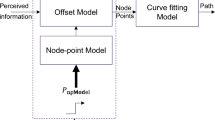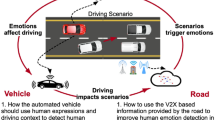Abstract
A haptic driver–vehicle steering interface is introduced that interacts with the driver through environmentally mediated torque and stiffness changes, thereby communicating the vehicle’s proximity to constraints in the driving environment. The system design is based on principles of distributed cognition, which are used to shape the force characteristics to provide the driver with a tangible, rich, distributed representation of the task constraints. This mapping of the task constraints aids the human operator in satisfying a variety of needs, including managing risk, maintaining contextual awareness and achieving a satisfactory level of performance. The proposed design philosophy was applied to implement a haptic steering system in a real-world test vehicle to assist drivers in navigating through an experimental course with tight passages. In tests conducted with 12 participants, not only did most drivers show improved performance, but activities identified as epistemic behaviors were also observed; in the context of driving, epistemic behaviors are actions through which a driver probes the environment to maintain contextual awareness for the purpose of actively maintaining a satisfactory balance between performance and risk. These findings indicate that the proposed system design allows humans to actively integrate the haptic interface system into their cognitive loops and that the resulting human–machine system achieves higher performance than the human alone. The observed human–machine system interaction is interpreted as achieving improved resilience against variations in environmentally imposed risks.

















Similar content being viewed by others
References
Abbink DA, Mulder M, der Helm FCTV, Mulder M, Boer ER (2011) Measuring neuromuscular control dynamics during car following with continuous haptic feedback. IEEE Trans Syst Man Cybern Part B Cybern 41(5):1239–1249
Abbink DA, Mulder M, Boer ER (2012) Haptic shared control: smoothly shifting control authority? Cogn. Technol. Work 14(1):19–28
Beall AC, Loomis JM (1996) Visual control of steering without course information. Perception 25(4):481–494
Boer ER, Hildreth EC, Goodrich MA (1998) A driver model of attention management and task scheduling: satisficing decision making with dynamic mental models. In: Proceedings 17th European annual conference on human decision making and control, p 98
Boer ER, Caro S, Cavallo V (2007) A cybernetic perspective on car following in fog. In: Proceedings of the fourth international driving symposium on human factors in driver assessment, training and vehicle design, pp 452–458
Cook R, Rasmussen J (2005) “Going solid”: a model of system dynamics and consequences for patient safety. Qual Saf Health Care 14(2):130–134
Donges E (1978) A two-level model of driver steering behavior. Hum Factors 20(6):691–707
Endsley MR (1995) Toward a theory of situation awareness in dynamic systems. Hum Factors 37(1):32–64
Flemisch FO, Bengler K, Bubb H, Winner H, Bruder R (2014) Towards cooperative guidance and control of highly automated vehicles: H-mode and conduct-by-wire. Ergonomics 57(3):343–360
Gibson JJ, Crooks LE (1938) A theoretical field-analysis of automobile-driving. Am J Psychol 51(3):453–471
Godthelp H, Milgram P, Blaauw GJ (1984) The development of a time-related measure to describe driving strategy. Hum Factors J Hum Factors Ergon Soc 26(3):257–268
Goodrich MA, Boer ER (2000) Designing human centered automation: tradeoffs in collision avoidance system design. IEEE Trans Intell Transp Syst 1(1):40–54
Goodrich MA, Stirling WC, Boer ER (2000) Satisficing revisited. Minds Mach 10(1):79–109
Griffiths PG, Gillespie RB (2005) Sharing control between humans and automation using haptic interface: primary and secondary task performance benefits. Hum Factors J Hum Factors Ergon Soc 47(3):574–590
Hegedüs F, Bécsi T, Aradi S, Gáspár P (2017) Model based trajectory planning for highly automated road vehicles. In: Proceedings of the 20th IFAC world congress, pp 7152–7158
Hirzinger G, Heindl J, Landzettel K, Brunner B (1992) Multisensory shared autonomy—a key issue in the space robot technology experiment rotex. In: Proceedings of the 1992 lEEE/RSJ international conference on intelligent robots and systems, vol 1, pp 221–230
Hollan J, Hutchins E, Kirsh D (2000) Distributed cognition: toward a new foundation for human–computer interaction research. ACM Trans Comput Hum Interact 7(2):174–196
Hollnagel E (2006) Resilience: the challenge of the unstable. In: Hollnagel E, Woods D, Leveson N (eds) Resilience engineering: concepts and precepts. Ashgate Publishing, Aldershot, pp 9–17
Hutchins E (1995) Cognition in the wild. MIT Press, Cambridge
Hwang J, Huh K, Na H, Jung H, Kang H, Yoon P (2008) Evaluation of lane keeping assistance controllers in HIL simulation. In: Proceedings of the 17th IFAC world congress, vol 41, no 2, pp 9491–9496
Inagaki T (2003) Adaptive automation: design of authority for system safety. IFAC Control in Transportation System, Tokyo, pp 13–22
Inagaki T (2006) Design of humanmachine interactions in light of domain-dependence of human-centered automation. Cogn Technol Work 8(3):161–167
Inagaki T (2009) Human–machine collaboration for safety and comfort. In: ENRI international workshop on ATM/CNS, pp 127–130
Inagaki T (2011) To what extent may assistance systems correct and prevent erroneous behaviour of the driver? In: Cacciabue P, Hjalmdahl M, Luedtke A, Riccioli C (eds) Human modelling in assisted transportation: models, tools and risk methods. Springer, Milano, pp 33–41
Inagaki T, Itoh M (2013) Humans overtrust in and over reliance on advanced driver assistance systems: a theoretical framework. Int J Veh Technol 2013:1–8
Itoh M, Flemisch F, Abbink D (2016) A hierarchical framework to analyze shared control conflicts between human and machine. IFAC PapersOnLine 49(19):96–101
Iwano K, Raksincharoensak P, Nagai M (2014) A study on shared control between the driver and an active steering control system in emergency obstacle avoidance situations. In: Proceeding of the 19th IFAC world congress, vol 47, no 3, pp 6228–6343
Katzourakis DI, de Winter JC, Alirezaei M, Corno M, Happee R (2014) Road-departure prevention in an emergency obstacle avoidance situation. IEEE Trans Syst Man Cybern Syst 44(5):621–629
Kirsh D (2006) Distributed cognition: a methodological note. Pragmat Cogn 14(2):249–262
Kirsh D, Maglio P (1994) On distinguishing epistemic from pragmatic action. Cogn Sci 18(4):513–549
Kishida E, Uenuma K, Iwao K, Matsuzaki N, Shigemasu H, Kitazaki M, (2009) A study on a device for controlling visual information to improve driver performance. SAE Technical Paper 2009-01-0548
Kudo H, Horiguchi Y, Sawaragi T, Nakanishi H (2015) Train driver support interface based on visualization of running time constraints. Trans Soc Instrum Control Eng 51(3):171–180
Kuge N, Yamamura T, Boer E, Ward N, Manser M (2006) Study on drivers car following abilities based on an active haptic support function. In: SAE Technical Paper, SAE International
Land M, Horwood J (1995) Which parts of the road guide steering? Nature 377:339–340
Land MF, Lee DN (1994) Where we look when we steer. Nature 369(6483):742–744
Leelavansuk P, Shitamitsu K, Mouri K, Nagai M (2002) Study on cooperative control of driver and lane-keeping assistance system. In: Proceeding of the international symposium on advanced vehicle, control, pp 219–224
Leelavansuk P, Yoshida H, Nagai M (2003) Cooperative steering characteristics of driver and lane-keeping assistance system. Int J ITS Res 1(1):17–24
Liu JF, Wu JH, Su YH (2007) Development of an Interactive lane keeping control system for vehicle. In: IEEE vehicle power and propulsion conference, Arlington, TX, pp 702–706
MacAdam CC (2003) Understanding and modeling the human driver. Veh Syst Dyn 40(1–3):101–134
Maglio P, Wenger M, Copeland A (2003) The benefits of epistemic action outweigh the costs. In: Proceedings of the 25th annual cognitive science society, pp 752–757
Mouri H, Nagai M (2001) Study on automatic path tracking with steering torque input. Trans Jpn Soc Mech Eng C(66–664):3836–3843
Nilsson J, Fredriksson J, Coelingh E (2017) Trajectory planning with miscellaneous safety critical zones. In: Proceedings of the 20th IFAC world congress, pp 9413–9418
NHTSA (2013) Preliminary statement of policy concerning automated vehicles. Tech. rep, National Highway Traffic Safety Administration
Parasuraman R, Wickens CD (2008) Humans: still vital after all these years of automation. Hum Factors 50(3):511–520
Pohl J, Ekmark J (2003) A lane keeping assist system for passenger car-design aspects of the user interface. In: Proceedings of the 18th international technical conference on the enhanced safety of vehicles
Rasmussen J (1983) Skills, rules, and knowledge; signals, signs, and symbols, and other distinctions in human performance models. IEEE Tran Syst Man Cybern SMC 13(3):257–266
Rasmussen J (1997) Risk management in a dynamic society: a modelling problem. Saf Sci 27:183–213
SAE (2014) J3016: taxonomy and definitions for terms related to on-road motor vehicle automated driving systems. Tech. rep, SAE International
Salvucci DD (2006) Modeling driver behavior in a cognitive architecture. Hum Factors J Hum Factors Ergon Soc 48(2):362–380
Sawaragi T (2008) Design theory for dynamical systems with semiosis. In: SICE annual conference, pp 375–380
Sawaragi T (2016) Human-system co-creative design of resilience. IFAC PapersOnLine 49(19):468–473
Shimakage M, Satoh S, Uenuma K, Mouri H (2002) Design of lane-keeping control with steering torque input. JSAE Rev 23(3):317–323
Stevens SS (1957) On the psychophysical law. Psychol Rev 64(3):153–181
Takahashi A, Hayashi K, Sasaki M (2003) Movement sequences for cracking an egg. In: Rogers S, Effken J (eds) Studies in perception and action VII, LEA, 10 Industrial Avenue, Mahwah, NJ, pp 165–169
Wada T, Doi S, Nishiyama A, Isaji K, Tsuru N, Kaneko H (2008) Analysis of braking behavior in car following and its application to driver assistance system. In: Proceeding of 9th international symposium on advanced vehicle control, pp 577–583
Woltjer R (2008) Resilience assessment based on models of functional resonance. In: Proceedings of the 3rd symposium on resilience engineering
Wood D (2006) Essential characteristics of resilience. In: Hollnagel E, Woods D, Leveson N (eds) Resilience engineering: concepts and precepts. Ashgate, Aldershot, pp 21–33 (chap 2)
Author information
Authors and Affiliations
Corresponding author
Rights and permissions
About this article
Cite this article
Takada, Y., Boer, E.R. & Sawaragi, T. Driver assist system for human–machine interaction. Cogn Tech Work 19, 819–836 (2017). https://doi.org/10.1007/s10111-017-0439-x
Received:
Accepted:
Published:
Issue Date:
DOI: https://doi.org/10.1007/s10111-017-0439-x




